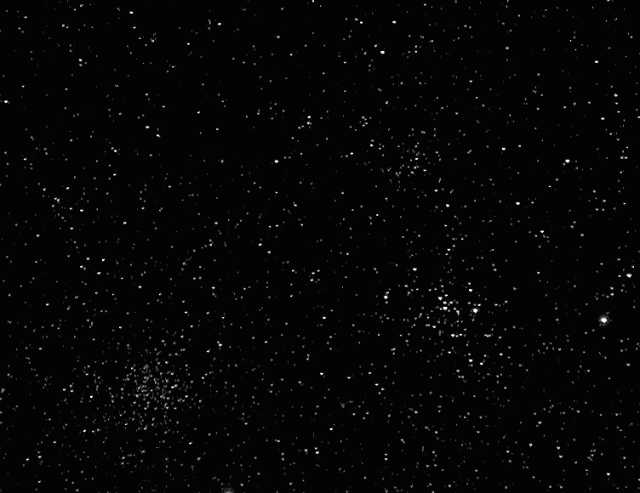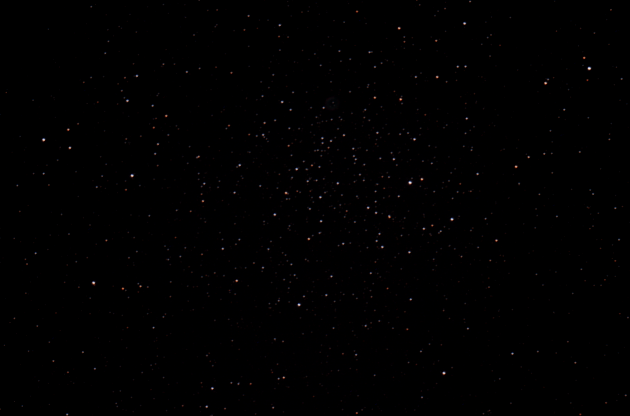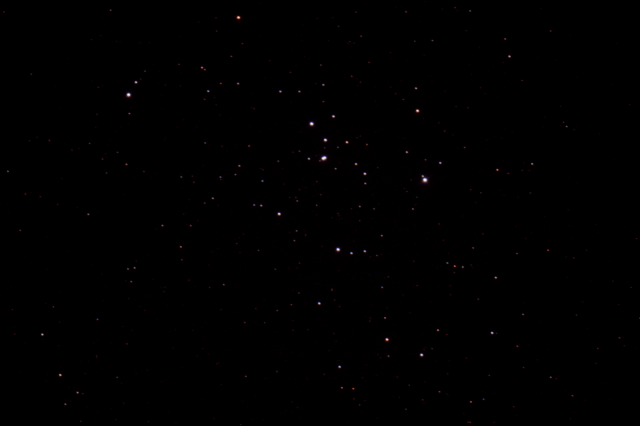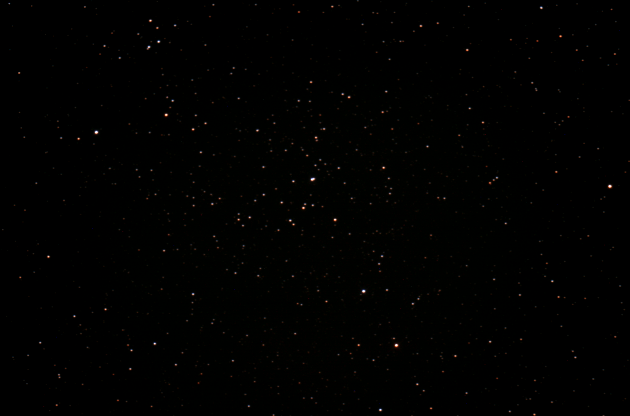

Both M46 and M47 were discovered by Charles Messier in 1771, but M47 (much the brighter of the pair) had been observed by Giovanni Hodierna sometime prior to 1654. M46 is a very rich cluster of at least 500 stars of which 150 are between 10th and 13th magnitude. The brightest star is magnitude 8.7 and is at least 100 times more luminous than the Sun. Its distance is 5,400 light-years, it is around 30 light-years in diameter, and 300 million years old. Superimposed on the cluster, but not part of it is a planetary nebula, NGC 2438 magnitude 11, which is not visible in my picture. M47 is a very loose cluster of at least 50 stars in a region 12 light-years across. It is 1,600 light-years away and estimated to be 78 million years old. I have found little information about NGC 2324; it contains about 86 stars the brightest of which is magnitude 9.

|
These clusters are about as far south as I can see from my observatory (their declinations are almost -15°) and I had about 30 minutes to image them, so there was no time to change optics or filters. So I contented myself with a wide-angle picture of all three of them together. Move your mouse pointer over the image to see them identified. I have used the size and (as far as I am able) the position shown by Cartes du Ceil to position my outlining circles. Date and Time: 11th February 2012 22:56 to 23:04 UT Camera: MX716 Telescope: 135-mm SLR lens at f5.6 with Astronomik CLS filter. Capture: star_mx7. 45 sec, 10 frames. Processing: Registax. 10 frames stacked. PhotoImpact. Removal of light pollution, reduction to size, and some adjustments in Focus Magic. |
||

|
A closer picture of M46 taken with my Ritchey-Chrétien telescope and a DSLR camera. Date and Time: 7th March 2018 21:34 UT Camera: Canon D600 modified Telescope: 8-inch Ritchey-Chrétien. Capture: 30, 60, 120, 240 seconds exposure at ISO 400. Processing: Registax5. Four frames stacked. PhotoImpact. Removal of light pollution, reduction to size. | ||

|
A closer picture of M47 taken with my Ritchey-Chrétien telescope and a DSLR camera. Date and Time: 7th March 2018 21:45 UT Camera: Canon D600 modified Telescope: 8-inch Ritchey-Chrétien. Capture: 6, 15, 30, 60, 120 seconds exposure at ISO 400. Processing: Registax5. Five frames stacked. PhotoImpact. Removal of light pollution, reduction to size. |
||

|
A closer picture of NGC 2423 taken with my Ritchey-Chrétien telescope and a DSLR camera. This is a faint and dispersed cluster which is difficult to identify. In the mouseover I show my best estimate of where the cluster is based on the size given in Cartes du Ciel and its location as indicated by in-the-sky.org. That is not to say that all the stars inside the circle and no stars outside the circle are members of the cluster. Open clusters do not tend to have sharp boundaries. It is believed that the cluster contains at least 50 stars. Date and Time: 7th March 2018 21:54 UT Camera: Canon D600 modified Telescope: 8-inch Ritchey-Chrétien. Capture: 30, 60, 120, 240 seconds exposure at ISO 400. Processing: Registax5. Four frames stacked. PhotoImpact. Removal of light pollution, reduction to size, and an increase in contrast (+20) |
||
Home Back to DSOs